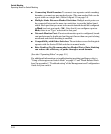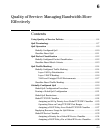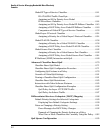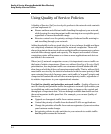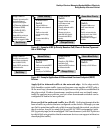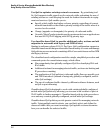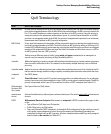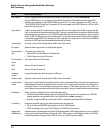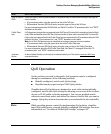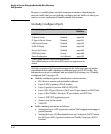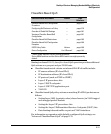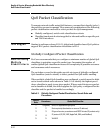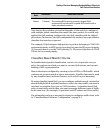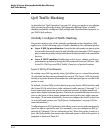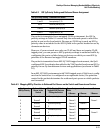
Quality of Service: Managing Bandwidth More Effectively
QoS Terminology
Term Use in This Document
DSCP policy A DSCP codepoint that is configured with an 802.1p priority (0 to 7). Default: No-override.
Using a DSCP policy, you can configure the switch to prioritize IP packets that match a specified
classifier by assigning a new DSCP and 802.1p priority (0-7). For more information on DSCP, refer to
“IPv4 ToS/IPv6 Traffic Class Byte” on page 6-42. For an example of the DSCP bit set in a ToS or Traffic
Class field, see Figure 6-13.
edge switch In QoS, an edge switch is a switch that receives traffic from the edge of the LAN or from outside the
LAN, and forwards it to devices within the LAN. Typically, an edge switch is used with QoS to identify
packets based on classifiers such as TCP/UDP application type, IP-device (address), Layer 3 protocol
(LAN), VLAN-ID (VID), and source port (although it can also be used to classify packets on the basis of
IP precedence and DSCP bits). Using this packet recognition, the edge switch can be used to set 802.1p
priorities or DSCP policies that downstream devices will honor.
inbound port Any port on the switch through which traffic enters the switch.
IP options Optional fields supported in an IPv4 packet header.
IP precedence The upper three bits in the:
bits
• Type of Service (ToS) byte of an IPv4 packet
• Traffic Class byte of an IPv6 packet
IP precedence See Type-of-Service (ToS), below.
mode
IPv4 Version 4 of the IP protocol.
IPv6 Version 6 of the IP protocol.
outbound A packet leaving the switch through any LAN port.
packet
outbound port Any port on the switch through which traffic leaves the switch.
outbound port On any port, a buffer that holds outbound traffic until it is transmitted from the switch through the port.
queue Depending on the switch, by default, there are either four or eight outbound queues for each port on
the switch. Queue 4 or 8 is the highest priority queue; queue 1 is the lowest priority queue. Traffic in a
port’s high priority queue leaves the switch before any traffic in the port’s medium or low priority queues.
QoS policy Defines a policy configured in one of the following ways:
• Classifier-based: Rate-limiting and/or prioritizing (by 802.1p priority, IP precedence, or DSCP bit
setting) packets in a specified traffic class (defined by the class command).
• Globally-configured: 802.1p priority and/or DSCP codepoint (with global QoS commands)
re-marking Assigns a new QoS policy to an outbound packet by changing the:
• Class-of-Service (CoS) 802.1p bit setting in Layer 2 VLAN headers
• DSCP bit setting in the Layer 3 IPv4 ToS byte (or IPv6 Traffic Class byte).
tagged port Identifies a port as belonging to a specific VLAN and enables VLAN-tagged packets to carry an 802.1p
membership priority when sent from the port in outbound traffic. When a port is an untagged member of a VLAN,
outbound packets belonging to the VLAN do not carry an 802.1p priority setting.
6-8



